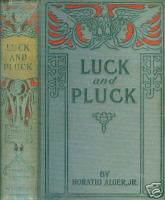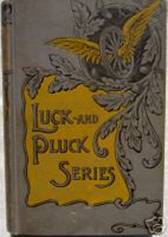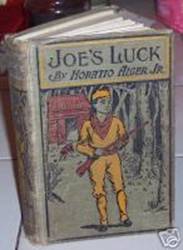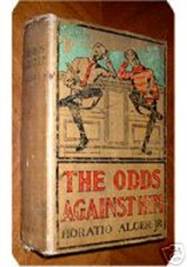Collecting Horatio Alger, Jr.
Online Auctions and the Beginning Collector
by Barry Schoenborn, PF-1087
(Click here to download this article as a PDF file.)
There are many ways to build a collection of Horatio Alger books, and the online auction has many advantages. However, there are pitfalls, too, for the beginning collector.
Experienced collectors will tell you what a great thrill it is to find a long-sought-after book in a small shop, at an estate sale, in a yard sale, or at an antiquarian book fair. But they’ll also tell you that those thrills are becoming scarcer.
I believe they’ll also tell you these realities:
- You can go to a book fair with 60 vendors and find few (or no) Algers. Juveniles will not be where the money is for book dealers. Also, Alger collecting is a smaller niche than most other collectible juveniles (Oz, Stratemeyer Syndicate, etc).
- Small shops are pricy places to find Alger, and quite often the books aren’t worth the money you pay.
- The publication and distribution of Alger is such (originally in New York, Boston, Philadelphia, Cleveland, and Chicago) that the farther west you go, fewer yard and estate sales are likely to have any great number of Alger books.
So what’s a beginner to do? Go to eBay. Online auctions have both common and rarer Alger books. And you can buy from the convenience of your own home. You’ll still be able to search yard sales, book fairs, and small shops, of course, but you’ll get the most results from your purchasing efforts on eBay.
This isn’t a perfect setup. In particular, you can’t inspect a book on eBay before buying. But if you approach eBay intelligently, and with adequate preparation, you can buy good Alger books you want at prices you can afford.
Your Start
Whether you found a single Alger book in a shop or got one as a gift, you now possess an irrational urge to collect more.
Something like that happened to me. I had a few old books, bought here and there. They were boys’ fiction, and not Algers. “X Bar X Boys Riding for Life” and “Air Service Boys Flying for Victory” come to mind.
I had always admired the basic message of Horatio Alger, and one day my girlfriend bought me three old reprints in an antique store. I got so excited that I went out searching for more.
BEGIN WITH STEP #2
You’re going skip step #1 no matter what I say, so I won’t try to stop you.
You are likely to go out to eBay and buy a bunch of Algers. Many will be in bad shape and have little collector value. If you’re going to go for the “low hanging fruit,” like I did, just be careful about spending a lot of money. Some reprints sell for between $0.99 and $4.99 because that’s all they’re worth. They are from publishers like M.A. Donahue Company and Winston. Some are really beat up and may have missing pages.
I then fell into the trap that most beginning Horatio Alger collectors do (and I have learned that an esteemed Horatio Alger Society (HAS) member says the same thing). That is, I started buying anything and everything that had Horatio Alger’s name attached. The result? Same as above, only more costly. I ended up with a lot of books, mostly junk. Experienced HAS members would call them “cheapies.”
Just the same, you’re going to get a good feeling from this. Until discontent sets in, because at some point, an urge to own a first edition will hit you. Now, there’s some homework to be done.
Time for step #1. Don’t worry; everyone will forgive you when you say, “Duh! I should have done step #1 first!”
NOW GO BACK TO STEP #1
Now it’s time to do what you should have done in the first place. These are the things that you need to do to start on the road to becoming a serious Alger collector:
1. Consult authoritative bibliographies (Bennett, Gardner and Chase, listed on this site HERE). These exhaustive publications will help you to identify both the common publishers and the publishers of the first edition Algers.
2. Join the Horatio Alger Society. This group has a scholarly and authoritative newsletter, and is filled with devoted members. When members help you, you will immediately get on the right track and stay on it. You will find that collecting Alger books is fun and rewarding.
3. Go to the Internet and find at least one set of definitions of book quality or condition (e.g., Independent Online Booksellers Association https://www.ioba.org/conditions-definitions). That way, when a seller describes a book as “very good,” “vg+,” or “fine,” you’ll have a clue what that means. Please remember that everyone has his or her own method of grading books!
4. From this site, print the list of Alger first editions and the list of Alger reprint titles. Go HERE for firsts and HERE for reprints.
5. In time, you will grow familiar with the many Alger publishers, and the seemingly endless cover formats used in publishing his books. A number of HAS collectors make it a point to collect far more than first editions, and that includes complete sets of reprints in a particular format.
6. Form a plan. Generally, collecting “firsts” is a good idea. These could cost between $35.00 and $1,200.00, based on scarcity and condition. But now you’ll be buying books regarded for collectability.
(And note that from time to time you will find a bargain, if the book is the genuine article. I’ve bought $80.00 books for $9.00, if and when they proved to be real firsts. I once bought a Twain first edition for $21.00 when the same book was selling at a local bookseller for $200.00!)
Ebay Tips
eBay is a strange and wonderful place, and you will find (or may have already found) that most sellers are very decent people. But it must also be said that most of them are not bibliophiles. Even the few who own bookstores or antique shops will point out that they have not studied their offerings carefully. So here are some tips.
Tip #1 – Beware Accidental (or Deliberate) Mislabeling or Puffery
Most eBay sellers offering Alger books know little about what they are selling (and some will be forthright enough to say so). They frequently offer books at too high a price, but their biggest offense is just plain getting the facts wrong.
Consider this example:
 |
The seller says: Wait and Hope, or A Plucky Boy’s Luck. By Horatio Alger, Jr. Published by New York Book Company. This book was published in 1908. The book has a nicely illustrated cover. This book is 163 pages in length. It measures 5"W x 7-1/4"H. There is a name, hand written on the inside cover. This book has 1 rip on the first blank page. It is in good condition for the age. A real collector’s book! |
NO! It’s not a first edition. The first edition was titled Wait and Hope; or, Ben Bradford’s Motto and was published in 1877 by Loring. There’s no reason to believe that it’s a “real collector’s book.”
Sellers use the copyright date and copyright holder frequently, but fail to mention the publisher. The publisher’s name is the first important distinction between a first edition and a reprint. When a seller states that a book is a first edition, check it! Look it up in your reference books and find out if in fact it is.
Tip #2 – Avoid Gross Overpricing
Since sellers often don’t know what they are selling, some of them think “old book” means “rare book,” and will set too high a starting price for the bidding.
Consider this example:
|
The seller says: 1897. The John C. Winston Co., Philadelphia. 343 pages plus advertising. Illustrated. Part of the Luck and Pluck series. Hard Cover.
|
No misrepresentation, but the seller is asking $30.00 to start. A little much for a typical Winston.
The first edition was published in 1869 by Loring, and one reference (Mattson & Davis) suggests a price of $75.00-$300.00 for a first edition, depending on condition.
Tip #3 – Don't Be Afraid to Negotiate
There will be occasions when a seller offers a desirable book on eBay that’s grossly overpriced. When you see this happen, watch the item. If no bids are made, contact the seller promptly after the auction ends and make a reasonable offer. A seller will often take the offer because 1) since the item didn’t get any bids, the seller has grounds to conclude that his/her item was overpriced, and 2) the seller avoids eBay fees by selling the item in a private transaction rather than on eBay.
eBay does not like you to conduct transactions off-site for this reason, but it is not illegal. If the seller is excessively concerned about eBay rules, all you can do is suggest that the seller relist the item and respectfully suggest that the start price should be lower.
One caution: you need to exercise some finesse and judgment when making a post-auction offer to a seller. If you attempt to lowball a seller (whether knowledgeable or naive), you shouldn’t be surprised if you get a curt reception. My advice is to make a fair offer.
I have these helpful comments from an experienced HAS member:
Naturally, the above strategy can also be employed at fixed-price on-line sites like ABEbooks.com (ABE), or even at book fairs and open book stores. Again, finesse and judgment are required.
For example, the most expensive Alger item currently offered on ABE is a first edition “Grand’ther Baldwin’s Thanksgiving,” inscribed by Alger to fellow author J.T. Trowbridge. This is a very nice item, but it’s listed for $6500.00 and is overpriced (IMHO) by two or three times what it should be. This copy has been sitting on ABE for years. I’d bet the seller would listen to any reasonable offer.
Ditto for conventional bookstores. I once bought two very nice Porter & Coates copies from an open store where they had sat on the shelf for a year because the dealer had mis-identified them as first editions. I made a reasonable offer in good faith and he took it.
Similarly, I have gotten dealers at book fairs to reduce their asking price by making reasonable offers on the last day of the fair. Book fair dealers don’t want to haul books home. By the way, I expect to pay more (in general) for books at a book fair because the dealers have setup and travel costs. So you should take this into account when asking book fair dealers to reduce their asking prices.
To recap, don’t be afraid to make respectful and reasonable offers to sellers whose books are demonstrably overpriced. Your offer won't always be accepted, but you will succeed often enough to make it worth the effort.
Tip #4 – Avoid Subtle Seller Errors, If You Can
Close doesn’t count, especially when a seller says a book is a “first edition.” The following illustrates a research gap, and a declaration (probably unintentional) that the book is a first edition.
|
The seller says: Horatio Alger - Strong And Steady - 1st Edition – 1871 5 1/4" X 7 5/8", gray cloth, black and gold stampings, 362 pp. "Strong And Steady Or Paddle Your Own Canoe By Horatio Alger Jr., Philadelphia, Henry T. Coates & Co. 1871" 1st edition and the third installment in the "Luck And Pluck" series. Slightest aging on covers, otherwise mint. Really a choice example of this scarce and desirable book. Full refund less shipping if not completely satisfied. $4.00 shipping. |
Well, not exactly a first edition. The HAS site points out that “Strong and Steady” was published by Loring in 1871. A first edition (according to Mattson & Davis) would sell for $60.00-$110.00. However, this book is from Henry T Coates’ “Flying Wheel” series, which is of some interest, and the book sold for $22.74.
Or this one:
|
The seller says: Here is a decent copy of JOE'S LUCK by HORATIO ALGER Jr. copyrighted and published by the A.L. BURT COMPANY of NEW YORK in 1887. There is wear on the outside cover which is also partially separated inside, front and back. Previous owners names on front and back endpage. Please e-mail any questions.
|
A.L. Burt did publish “Joe’s Luck” in 1887, and that’s not doubted. But this seller is probably reading the copyright page of this book. Reason? The Brad Chase reference shows the A.L. Burt formats for the Joe’s Luck series, and this one is not among them. However, Chase identifies this format as “Format No. 31, Hunter Format,” part of the Chimney Corner Series, and says A.L. Burt produced the series from 1905 through 1917. Not likely to have been used for the 1887 first edition.
The seller makes no misstatements, but this is certainly not a first edition. Starting bid: $0.99, with no takers.
Tip #5 – HAS Doesn’t Endorse
The following says that the book isn’t seen very often, “according to the Horatio Alger society [sic]”. Maybe it’s true that it’s not seen often, but I couldn’t locate those words on the HAS website. Further, such a statement implies that the HAS believes this book has scarcity or value. Some members might think so; some might not. I’m sure that HAS has no official position on this.
|
The seller says: THE ODDS AGAINST HIM OR CARL CRAWFORD’S EXPERIENCE by Horatio Alger Jr. Published by The Penn Company in 1904, this is a very scarce early edition from the original publisher. The story about Carl’s fortune after he leaves his invalid father’s house and how he gets a place of his own and what he learns in Chicago, 345 pages. 6 b/w plate illustrations, the first at the frontispiece, covered with transparency. Endpapers are illustrated. Binding is illustrated at front with gilt bordering, 7.5” tall. With good inner pages and a fair to poor binding, the wear is: All pages are intact and without markings. Amber age spots on some of the pages, infrequent. Binding is rubbed at front illustration and lettering but they are still fairly strong. Lettering at spine is nearly rubbed away but traceable. Spine is torn all along back edge but still attached. Back board is cracked and weak but still holding. An Alger antique book not seen very often, according to the Horatio Alger society! |
The book is listed with a starting price of $99.00.
Is it a first edition? Not close, and no cigar. According to the Bennett bibliography, the first edition was indeed published by The Penn Publishing Company, but in 1890. And the format is wrong.
Tip #6 – Factor In Shipping
When you win an auction, your book will most likely be sent to you via USPS Media Mail. It’s quite cheap, but it can typically take two weeks for you to get the item. Another curiosity is that sellers charge much more for shipping than the actual postage, but to be fair to them, consider that they have to wrap, box, and ship the item.
From the standpoint of total price, keep in mind that buying a $3.00 book with $4.00 in shipping charges means you’ve paid $7.00 for it, and that may change your perception of the book’s “worth.” You may think it’s more valuable, but once you receive it and catalog it, the book pretty much returns to being a $3.00 item.
Just remember, you can see shipping costs before you bid. If a book’s shipping costs are too high, you may want to avoid bidding or e-mail a question to the seller, asking questions about the shipping and the cost. Generally, they are very willing to work with buyers, if you ask properly.
On the other hand, for your most important purchases, don’t fret about using Priority Mail or requesting insurance. I do this on books that cost over $100.00. Priority Mail typically adds about $3.00 to the postage, and insurance is only $1.35.
Tip #7 – Ask the Seller Questions
Don’t be afraid to ask the seller questions. If you need to know exactly what’s on the spine, or the exact rendering of text on the title page, or if the book has certain points to make it a first edition, send the seller a question. You might get exactly the answer you need – one that might prevent you from making a mistake.
Tip #8 – Bid to Win
Once you’ve found a title that attracts you, and you have a sense of what it’s worth, determine what it’s worth to you to own it. Be prepared to bid the maximum amount you are willing to spend. There are other Alger collectors out there, and they are thinking this way.
If you put in a low bid and lose the book, it’s entirely your own fault. Experience shows that a higher maximum helps squeeze out last-minute attempts to outbid you. Naturally, some folks will try to “snipe” you, but if your price is high enough, it will do them no good. “Sniping” is when someone places a bid in the last 6 seconds of an auction, making it impossible for you to respond.
Tip #9 – Don’t Give Up
You won’t win every auction, and not every auction is worth winning. HAS has many very experienced collectors, and you’ll see their handles come up all the time on eBay. When you lose an auction, determine what went wrong, and if you really lost anything. Then go on back and do it again!
Remember that experienced collectors face many of the same pitfalls that you do.
What To Do With Your Books
Eventually, your books will arrive. So what should you do with them? There are a couple of other vital steps in keeping your collection growing:
- Record keeping. You will do yourself an immense service by recording the key elements of your purchase. I wish I had done this from the start, but I had about 250 books before I started doing things in an organized way. I recommend that you number your books, and record title, subtitle, publisher (title page only), series, format (if you know it), date of purchase, and purchase price. Other items (such as inscriptions) are a fine extra. For this work, a personal computer is your best friend, but theoretically you could do this work on index cards.
- Read the books. What’s the point of all this work if you don’t get the satisfaction of reading and enjoying your books? Each one is a thrill to read. There’s not only the story, but also the satisfaction of opening a “new” (new to you) 140-year-old book for reading pleasure.
The Future – How It Usually Evolves
What’s in your future? I’ve talked with a few HAS members, and this is my best guess as to how your collecting will evolve. Not everyone takes the same path, or takes the steps in the same order, but all approaches get you to a good place.
- Buy reprints. An inescapable first step, usually by title (or “title collecting” as the Horatio Alger Society would define this type of collecting).
- Buy first editions. This is the first sign that you are a serious collector.
- Buy serializations. Eventually, you will locate and buy the early Alger magazine serializations, appearing in Argosy, Golden Argosy, Student and Schoolmate, etc. These magazines are where the first printing of some of the Horatio Alger titles—serialized, published every month for one year—made their first appearance, prior to being published in book form.
- Collect sets of reprints. There’s a special satisfaction in collecting complete sets of books in one format from one publisher. There are many titles and formats. It may take a long time, but they look great on your bookshelves.
- Collect unconventional publications. Alger appears in Civil War books, under pseudonyms, and through British publishers. To date, there were some 760+ short stories and poems, written by Horatio Alger, Jr., published in many periodicals, magazines, newspapers etc. Can you imagine one day finding a poem or short story published in some newspaper that no one has ever seen?
- Collect the odd and unexpected. Some members disdain them; other members love them. I have had great fun buying 1982 Alger stamps on day-of-issue covers. And I’ve bought Horatio Alger cup plates. I must say, however, that at this point, I’m not an autograph collector, mainly because of price.
And In Conclusion
Collecting Alger is an occupation and preoccupation with no conclusion. By no means have all the Alger works in all their variations surfaced. You may be the first to find a long-lost Alger artifact. You have decades of enjoyment ahead of you!
Barry Schoenborn
PF-1087
barry@wvswrite.com
(Click here to download this article as a PDF file.)







